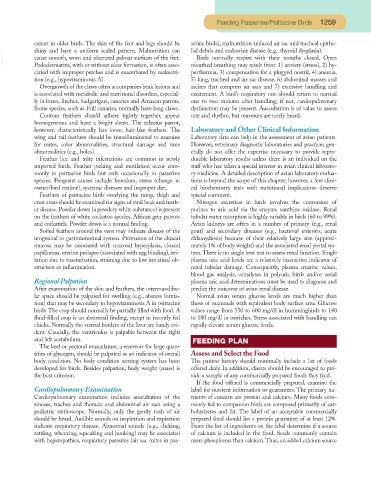Page 1209 - Small Animal Clinical Nutrition 5th Edition
P. 1209
Feeding Passerine/Psittacine Birds 1259
extent in older birds. The skin of the feet and legs should be serine birds), malnutrition-induced air sac and tracheal epithe-
VetBooks.ir shiny and have a uniform scaled pattern. Malnutrition can lial debris and endocrine disease (e.g., thyroid dysplasia).
Birds normally respire with their mouths closed. Open
cause smooth, worn and ulcerated palmar surfaces of the feet.
mouthed breathing may result from: 1) anxiety (stress), 2) hy-
Pododermatitis, with or without ulcer formation, is often asso-
ciated with improper perches and is exacerbated by malnutri- perthermia, 3) compensation for a plugged nostril, 4) anemia,
tion (e.g., hypovitaminosis A). 5) lung, tracheal and air sac disease, 6) abdominal masses and
Overgrowth of the claws often accompanies beak lesions and ascites that compress air sacs and 7) excessive handling and
is associated with metabolic and nutritional disorders, especial- excitement. A bird’s respiratory rate should return to normal
ly in lories, finches, budgerigars, canaries and Amazon parrots. one to two minutes after handling; if not, cardiopulmonary
Some species, such as Frill canaries, normally have long claws. dysfunction may be present. Auscultation is of value to assess
Contour feathers should adhere tightly together, appear rate and rhythm, but murmurs are rarely heard.
homogeneous and have a bright sheen. The eclectus parrot,
however, characteristically has loose, hair-like feathers. The Laboratory and Other Clinical Information
wing and tail feathers should be transilluminated to examine Laboratory data can help in the assessment of avian patients.
for mites, color abnormalities, structural damage and vane However, veterinary diagnostic laboratories and practices gen-
abnormalities (e.g., holes). erally do not offer the expertise necessary to provide repro-
Feather lice and mite infestations are common in newly ducible laboratory results unless there is an individual on the
imported birds. Feather picking and mutilation occur com- staff who has taken a special interest in avian clinical laborato-
monly in psittacine birds but only occasionally in passerine ry medicine. A detailed description of avian laboratory evalua-
species. Frequent causes include boredom, stress (change in tions is beyond the scope of this chapter; however, a few clini-
owner/bird routine), systemic diseases and improper diet. cal biochemistry tests with nutritional implications deserve
Feathers of psittacine birds overlying the rump, thigh and special comment.
crest areas should be examined for signs of viral beak and feath- Nitrogen excretion in birds involves the conversion of
er disease. Powder down (a powdery white substance) is present purines to uric acid via the enzyme xanthine oxidase. Renal
on the feathers of white cockatoo species, African grey parrots tubular water resorption is highly variable in birds (60 to 99%).
and cockatiels. Powder down is a normal finding. Avian kidneys are often in a number of primary (e.g., renal
Soiled feathers around the vent may indicate disease of the gout) and secondary diseases (e.g., bacterial enteritis, acute
urogenital or gastrointestinal system. Protrusion of the cloacal chlamydiosis) because of their relatively large size (approxi-
mucosa may be associated with mucosal hyperplasia, cloacal mately 1% of body weight) and the associated renal portal sys-
papillomas, uterine prolapse (associated with egg binding), irri- tem. There is no single best test to assess renal function. Single
tation due to masturbation, straining due to low intestinal ob- plasma uric acid levels are a relatively insensitive indicator of
struction or inflammation. renal tubular damage. Consequently, plasma creatine values,
blood gas analysis, urinalyses in polyuric birds and/or serial
Regional Palpation plasma uric acid determinations must be used to diagnose and
After examination of the skin and feathers, the intermandibu- predict the outcome of avian renal disease.
lar space should be palpated for swelling (e.g., abscess forma- Normal avian serum glucose levels are much higher than
tion) that may be secondary to hypovitaminosis A in psittacine those of mammals with equivalent body surface area. Glucose
birds.The crop should normally be partially filled with food. A values range from 550 to 600 mg/dl in hummingbirds to 140
fluid-filled crop is an abnormal finding, except in recently fed to 180 mg/dl in ostriches. Stress associated with handling can
chicks. Normally the ventral borders of the liver are barely evi- rapidly elevate serum glucose levels.
dent. Caudally, the ventriculus is palpable between the right
and left acetabulum. FEEDING PLAN
The keel or pectoral musculature, a reservoir for large quan-
tities of glycogen, should be palpated as an indicator of overall Assess and Select the Food
body condition. No body condition scoring system has been The patient history should minimally include a list of foods
developed for birds. Besides palpation, body weight (mass) is offered daily. In addition, clients should be encouraged to pro-
the best criterion. vide a sample of any commercially prepared foods they feed.
If the food offered is commercially prepared, examine the
Cardiopulmonary Examination label for nutrient information or guarantees. The primary nu-
Cardiopulmonary examination includes auscultation of the trients of concern are protein and calcium. Many foods com-
sinuses, trachea and thoracic and abdominal air sacs using a monly fed to companion birds are composed primarily of car-
pediatric stethoscope. Normally, only the gentle rush of air bohydrates and fat. The label of an acceptable commercially
should be heard. Audible sounds on inspiration and expiration prepared food should list a protein guarantee of at least 12%.
indicate respiratory disease. Abnormal sounds (e.g., clicking, From the list of ingredients on the label determine if a source
rattling, wheezing, squeaking and honking) may be associated of calcium is included in the food. Seeds commonly contain
with hepatopathies, respiratory parasites (air sac mites in pas- more phosphorus than calcium.Thus, an added calcium source

